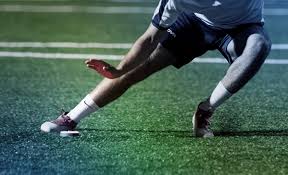Develop Deceleration Capacity Using Other High-Speed Outputs
Blog post description.


Decelerations require the use of large force outputs to change velocity and reduce momentum. This imposes a significant demand on the muscle-tendon structure and if the tissue is unable to meet the equivalent force required by the action the athlete is susceptible to mechanical failure. Sport specific actions such as decelerations that require underpinning physical qualities such as strength to enhance the players ability to perform the skill and reduce injury risk. However, it is by integrating deceleration into other on-field speed related activities that will provide the most specific augmentation in movement mechanics and physical adaptations. The purpose of this article is to provide options on how implement training for a high intensity physical action as much as necessary.
When prescribing 5-20m accelerations during the on-field session it is also an efficient option to incorporate deceleration mechanics into each repetition. This is a matter of putting four cones down 5m apart and having the athletes aggressively accelerate over a short distance before abruptly decelerating at an assigned cone. Competition should be regularly involved to increase the intensity of the acceleration and deceleration. Players will often try to gradually decelerate to minimise physical effort. However, it is through these less demanding repetitions that all allow the players to get close to an intensive deceleration before going into a chaotic environment and getting exposed to many. With younger athletes’ practitioners can use short distances for long periods of time to take time to reinforce quality movement patterns. It is particularly important around changing knee and hip flexion angle and adjusting the centre of mass. Starting from shorter distances will also allow the athletes to get more repetitions if required to improve the skill.
Using large distances to combine maximum velocity running and deceleration is a useful approach to enhancing the deceleration outputs. Using distances greater than 30m will allow athletes to accumulate high velocities to increase the demand during the deceleration that follows that rep. An appropriate method for bridging the gap between each of the actions is to start with 40m lane for each player. The 40m lane will have a cone on 0m, 30m, 32m, 36m, and 40m. On the first set the players will build as much speed as possible during between the 0-30m before coming to a gradual stop on the 40m. The goal is to increase the demand of the deceleration by reducing breaking distances as the session progresses and having the athletes break on the 36m mark and then 32m mark. The repetitions with the least breaking distances will challenge the movement mechanics of most players. The challenge with the prescribing this to large groups is that some players will try to get away with slowing their sprinting speed. Since this type of exercise can produce upwards of 90% maximal deceleration, it is easy to provide immediate objective feedback to those are cheating themselves from achieving a high-quality rep.
Creating sport-specific situation that produce high intensity deceleration is possible with moderate sided game. In soccer, some of the highest intensity actions occur from transitional moments. It is highly important to leverage this as a part of the training process, not just as a part of the physical development but these are also critical moments from a tactical and technical standpoint. Moderate sized games such as 7v7 can be reset in the first third of the attacking team within reduced gridlines. If one team successfully retains the ball for 5 passes, they are free to expand play and move the ball forward. If the defending team force their opponents to turnover possession, they are free to break towards goal. It is conditions such as this that encourage intense action during training. Already within the reset of the games there are 3 likely outcomes that will enhance training intensity and increase high band decelerations.
Deceleration is a key action in team sport, to appropriately prepare for these demands player must be exposed to intense versions of them as well as perform them with enough regularity that they become conditioned to them. The ideal volume will vary between sports and teams, however, a great place to start is learning how to produce them when necessary to manage prescribed targets. The purpose of this article is providing practitioner with options to involve specific mechanics or produce them organically through sport-orientated situations. It is critical to be flexible in your approach to enhancing outputs as this will allow the practitioner to offer solutions to coaches who are primarily focused on the technical or tactical part of the sport. This will allow practitioners to offer the most value and by being solution oriented will enrich the training process across the entire ecosystem.
